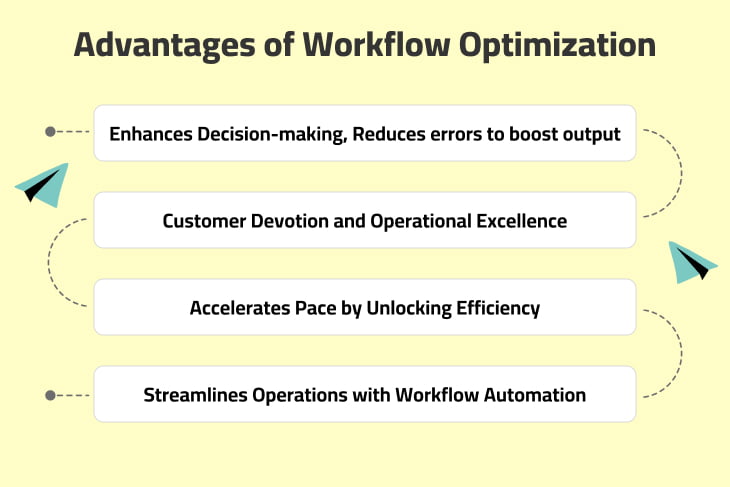We’ll know the practical ideas and tried-and-true tactics in this blog to help you maximize the efficiency of your team’s workflow. We’ll examine several workflow optimization strategies that can improve team performance and get your business closer to success.
Advantages of workflow optimization

- It helps you monitor the important parameters, that directly affect how well you make decisions. Additionally, it lowers mistakes and boosts output.
- Stronger bonds result in more devoted customers. The link between improved corporate operations and consumer expectations is workflow optimization. Workflows that are efficient allow your staff to assist more clients in less time. Improved processes may allow customer support inquiries that once took days to be addressed in a matter of hours, which pleases customers.
- Excessive workloads and ineffective procedures only make you go more slowly. Invest in work optimization to identify problem areas and permanently remove any bottlenecks.
- In order to reduce time and worries, work optimization entails automating laborious manual operations. Workflow automation software may be used for anything from purchase orders for procurement to onboarding new staff members.
5 Workflow optimization strategies
While every business has its own tips, these five optimization strategies are the most effective for achieving a more efficient workflow.
Project management tools
Project management tools not only keep track of all of the work activities, communications, and team members in one location, but it also makes workflow management simple.
The majority of project management tools are also workflow programs. This implies that you may do process analysis on a higher level using reporting capabilities like Dashboards and analytics, in addition to enjoying the benefits of managing projects in a single, user-friendly platform. It’s the ideal approach to examine your operations from both a broad and in-depth perspective. Alian hub allows you to manage workflow and workload with a dashboard and workload time sheet.
Automate the workflow
Manual procedures are often too time-consuming and might cause bottlenecks in projects. Automation is the greatest present you can offer your staff. There are several instances of automation being used to optimize workflows, such as:
- Using an automated onboarding procedure to streamline employee onboarding.
- Planning ahead for social media postings.
- Using automatic rules in your customer relationship management (CRM) software to handle leads.
- Selecting automation-enabled no-code workflow software is crucial. This way, without having to call IT for assistance, your team may implement as much workflow automation as they like.
Visualize the process
Work optimization requires visualization since it makes every stage of your work process visible. After all, it is much simpler to enhance a process when you can pinpoint precisely what is and isn’t functioning. Moreover, project management software facilitates experimentation with various processes until the most efficient methods are identified.
New approaches
If you do not believe your present processes are productive, it may be time to try something completely different. While not every organization may benefit from the same strategies. Thus, one of the work optimization strategies is changing development approaches.
- Lean teams aim to improve the system by visualizing and allocating work in the most efficient and sustainable way possible.
- Agile is an iterative work strategy that allows for continuous development and modifications. Because it emphasizes teamwork, this style is popular among programmers. However, it also benefits marketing, sales, and other project-based departments.
- If you enjoy statistics, you’ll enjoy Six Sigma. The goal of this approach is to use statistics to decrease performance variability.
Clear Communication and Collaboration
Implement collaboration tools that facilitate communication and document sharing. This reduces delays caused by information gaps. Clearly define communication channels and protocols to minimize misunderstandings and ensure information flows smoothly.
Conclusion
The path to workflow optimization is a never-ending progression for maximum productivity. Teams may use the ideas described in this post as a compass to help them navigate the ever-changing modern workplace and move toward a more efficient and productive future. Teams that prioritize flexibility, integrate technology, and promote open communication are better equipped to not just fulfill current needs but also anticipate and overcome future obstacles. Keep in mind that the real strength of workflow optimization is found in its capacity to empower people, foster better teamwork, and eventually lead to group success.

